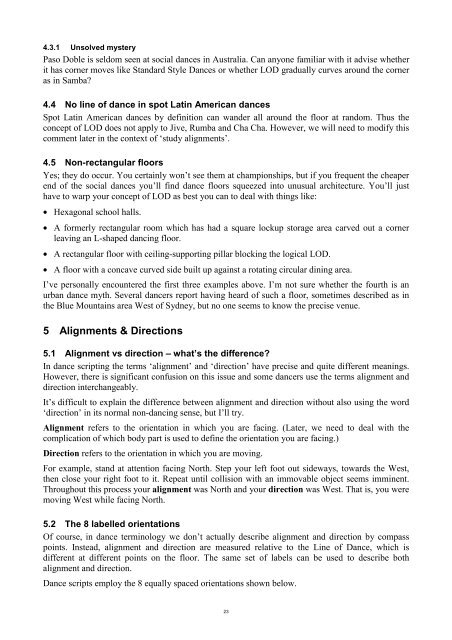Reading Ballroom Dance Scripts - Dance - Plussed.net
Reading Ballroom Dance Scripts - Dance - Plussed.net
Reading Ballroom Dance Scripts - Dance - Plussed.net
Create successful ePaper yourself
Turn your PDF publications into a flip-book with our unique Google optimized e-Paper software.
4.3.1 Unsolved mystery<br />
Paso Doble is seldom seen at social dances in Australia. Can anyone familiar with it advise whether<br />
it has corner moves like Standard Style <strong>Dance</strong>s or whether LOD gradually curves around the corner<br />
as in Samba?<br />
4.4 No line of dance in spot Latin American dances<br />
Spot Latin American dances by definition can wander all around the floor at random. Thus the<br />
concept of LOD does not apply to Jive, Rumba and Cha Cha. However, we will need to modify this<br />
comment later in the context of ‘study alignments’.<br />
4.5 Non-rectangular floors<br />
Yes; they do occur. You certainly won’t see them at championships, but if you frequent the cheaper<br />
end of the social dances you’ll find dance floors squeezed into unusual architecture. You’ll just<br />
have to warp your concept of LOD as best you can to deal with things like:<br />
• Hexagonal school halls.<br />
• A formerly rectangular room which has had a square lockup storage area carved out a corner<br />
leaving an L-shaped dancing floor.<br />
• A rectangular floor with ceiling-supporting pillar blocking the logical LOD.<br />
• A floor with a concave curved side built up against a rotating circular dining area.<br />
I’ve personally encountered the first three examples above. I’m not sure whether the fourth is an<br />
urban dance myth. Several dancers report having heard of such a floor, sometimes described as in<br />
the Blue Mountains area West of Sydney, but no one seems to know the precise venue.<br />
5 Alignments & Directions<br />
5.1 Alignment vs direction – what’s the difference?<br />
In dance scripting the terms ‘alignment’ and ‘direction’ have precise and quite different meanings.<br />
However, there is significant confusion on this issue and some dancers use the terms alignment and<br />
direction interchangeably.<br />
It’s difficult to explain the difference between alignment and direction without also using the word<br />
‘direction’ in its normal non-dancing sense, but I’ll try.<br />
Alignment refers to the orientation in which you are facing. (Later, we need to deal with the<br />
complication of which body part is used to define the orientation you are facing.)<br />
Direction refers to the orientation in which you are moving.<br />
For example, stand at attention facing North. Step your left foot out sideways, towards the West,<br />
then close your right foot to it. Repeat until collision with an immovable object seems imminent.<br />
Throughout this process your alignment was North and your direction was West. That is, you were<br />
moving West while facing North.<br />
5.2 The 8 labelled orientations<br />
Of course, in dance terminology we don’t actually describe alignment and direction by compass<br />
points. Instead, alignment and direction are measured relative to the Line of <strong>Dance</strong>, which is<br />
different at different points on the floor. The same set of labels can be used to describe both<br />
alignment and direction.<br />
<strong>Dance</strong> scripts employ the 8 equally spaced orientations shown below.<br />
23


